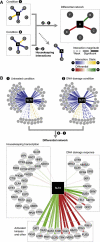Differential network biology
- PMID: 22252388
- PMCID: PMC3296360
- DOI: 10.1038/msb.2011.99
Differential network biology
Abstract
Protein and genetic interaction maps can reveal the overall physical and functional landscape of a biological system. To date, these interaction maps have typically been generated under a single condition, even though biological systems undergo differential change that is dependent on environment, tissue type, disease state, development or speciation. Several recent interaction mapping studies have demonstrated the power of differential analysis for elucidating fundamental biological responses, revealing that the architecture of an interactome can be massively re-wired during a cellular or adaptive response. Here, we review the technological developments and experimental designs that have enabled differential network mapping at very large scales and highlight biological insight that has been derived from this type of analysis. We argue that differential network mapping, which allows for the interrogation of previously unexplored interaction spaces, will become a standard mode of network analysis in the future, just as differential gene expression and protein phosphorylation studies are already pervasive in genomic and proteomic analysis.
Conflict of interest statement
The authors declare that they have no conflict of interest.
Figures



References
-
- Aebersold R, Mann M (2003) Mass spectrometry-based proteomics. Nature 422: 198–207 - PubMed
-
- Andersen CL, Jensen JL, Orntoft TF (2004) Normalization of real-time quantitative reverse transcription-PCR data: a model-based variance estimation approach to identify genes suited for normalization, applied to bladder and colon cancer data sets. Cancer Res 64: 5245–5250 - PubMed
-
- Aranda B, Achuthan P, Alam-Faruque Y, Armean I, Bridge A, Derow C, Feuermann M, Ghanbarian AT, Kerrien S, Khadake J, Kerssemakers J, Leroy C, Menden M, Michaut M, Montecchi-Palazzi L, Neuhauser SN, Orchard S, Perreau V, Roechert B, van Eijk K et al. (2010) The IntAct molecular interaction database in 2010. Nucleic Acids Res 38: D525–D531 - PMC - PubMed
Publication types
MeSH terms
Grants and funding
LinkOut - more resources
Full Text Sources
Other Literature Sources

